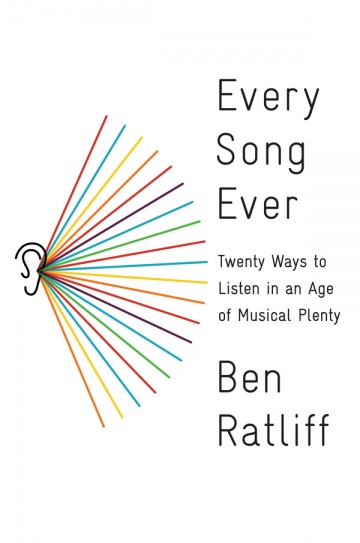Columbia College | Columbia University in the City of New York
Ben Ratliff ’90’s How-to Guide for the Empowered Listener
In the Thelonious Monk song “Thelonious,” there’s an eight-bar solo that can get a little uncomfortable because Monk insists upon a single note, over and over, grabbing his listeners by the ears. This same insistence appears in the Ramones’ “I Wanna Be Sedated,” Neil Young’s one-note guitar solo in “Cinnamon Girl” and a b-note only rap in Drake’s “Furthest Thing.”
Each of these tracks has that stubborn, repeated note reminding the listener: “Wake up, get free of your momentum, you have somewhere to be right now,” writes New York Times music critic Ben Ratliff ’90 in his music appreciation book Every Song Ever: Twenty Ways to Listen in an Age of Musical Plenty (Farrar, Straus and Giroux, $26).

That bossy “stubborn note” is one of 20 categories Ratliff suggests to serve as a framework for creative listening. His suggestions come in the era of Spotify and Pandora, when algorithms enable us to be “fed our favorite meal repeatedly,” he writes. While each chapter includes a playlist, Every Song Ever doesn’t tell you what to listen to. It tells you what to listen for, whether it’s a slow tempo, that “perfect moment” or a sense of place. By turning away from genres and toward specific qualities in songs, Ratliff enables his readers to understand what qualities they’re looking for when they listen to music.
Ratliff has written about music for the Times for 20 years. He has listened to much music, and intently so. Before the Times and the smaller publications he wrote for prior, his musical identity began to form as a teenager growing up in Rockland County, N.Y. There, he would take a bus to the East Village for a matinee punk show at CBGB and be back home in time for dinner. “I was aware of how much music was going on [in New York City], and that there was a real, endless world I could dive into,” he says.

KATE FOX REYNOLDS
This fascination led him to Columbia, where, in 1985, he first experienced the overwhelming feeling many of us now get opening Spotify or Apple Music. He was a substitute DJ on several WKCR shows before becoming the station’s program manager. He remembers lockers of jazz records — 100 years of complex history towering over his mere 17 years. By connecting songs for sets, he started to understand music’s emotional power beyond its technical qualities. His later work with the Times solidified that concept; there, he didn’t limit himself to specializations. Instead, he chose to “roll the microscope back” and look at how the vocal delivery of an artist like Beyoncé might relate to a country singer like Hank Williams.
Having the opportunity to cover such a broad range of music for the Times meant Ratliff could make connections that spanned genres, he says. “I started thinking about things like slow tempos. They occur in all kinds of music. So what’s the power in them? What are they doing? And what does it mean to be listening to a slow tempo?”
Ratliff explored jazz criticism and history in his previous books: The Jazz Ear: Conversations over Music (2009), Coltrane: The Story of a Sound (2008) and Jazz: A Critic’s Guide to the 100 Most Important Recordings (2002). But writing a music appreciation book about genres from samba to gospel to southern rap was his response to what he calls a transformative moment in music’s history, resembling the advent of the record player.
Now, streamable radio tuned to listener preferences might start with a Chet Baker track, followed by Sonny Rollins, Billie Holiday, Art Tatum. Employing one of Ratliff ’s own categories — quietness — moves the listener from Baker to R&B singer Aaliyah to bossa nova pioneer João Gilberto to, surprisingly, a track by rock band Metallica. If it’s quietness the listener is after, these tracks provide intimacy, gulps of air before outbursts, suspense; in other words, our own actions and feelings, not genres.
“I wanted to suggest a spirit of listening such that we might be able to encounter things that are unfamiliar to us. And be able to recognize them on some level and say, ‘Oh yeah, that is about me too. That has something to do with me.’”
To be clear, Ratliff isn’t opposed to streaming services. But he doubts these services’ algorithms will ever correlate with human emotions — the soothing repetition of a James Brown rant, the commanding loudness of The Who, the sense of sadness in a Nick Drake song.
“Through listening, you figure out who you are, you build your identity and you learn about the world and your emotions and sensibilities. That’s too important a job to leave to robots.”
CCT Web Extra
Lauren Steussy is an arts and culture reporter on Staten Island. Her last profile for CCT was on CNN anchor and correspondent Poppy Harlow ’05 (Spring 2016). Steussy’s work has also appeared in The Staten Island Advance, on Cosmpolitan.com and in The Orange County Register.
Issue Contents
Published three times a year by Columbia College for alumni, students, faculty, parents and friends.
Columbia Alumni Center
622 W. 113th St., MC 4530, 6th Fl.
New York, NY 10025
212-851-7852
cct@columbia.edu
Columbia Alumni Center
622 W. 113th St., MC 4530, 4th Fl.
New York, NY 10025
212-851-7488
ccalumni@columbia.edu

